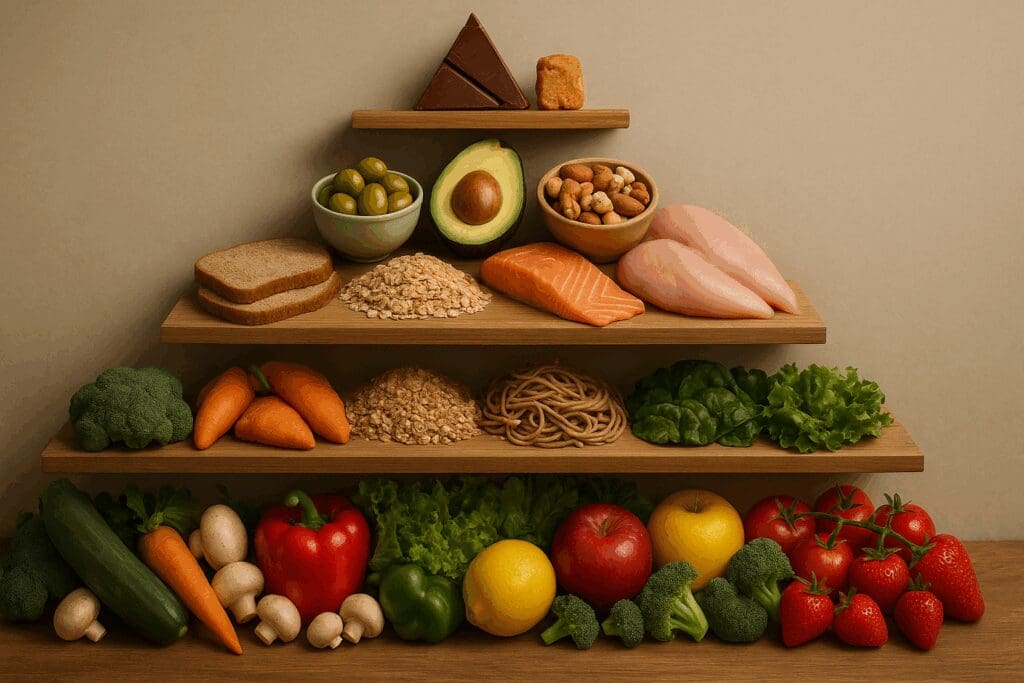Introduction: The Hidden Potential of a Balanced Plate of Food
In the realm of nutrition, the concept of a balanced plate of food transcends mere dietary guidelines; it embodies a holistic approach to health and well-being. A balanced plate of food is not just about satisfying hunger; it’s about nourishing the body, supporting metabolic functions, and preventing chronic diseases. This approach emphasizes the importance of variety and proportion in our meals, ensuring that we receive a comprehensive array of nutrients essential for optimal health.
The significance of a balanced plate of food lies in its ability to provide a structured yet flexible framework for healthy eating. By incorporating diverse food groups in appropriate proportions, individuals can achieve a diet that supports energy levels, cognitive function, and overall vitality. This method aligns with various dietary models, such as the USDA’s MyPlate and Harvard’s Healthy Eating Plate, which advocate for balanced consumption of fruits, vegetables, grains, proteins, and healthy fats.
Understanding and implementing the principles of a balanced plate of food can lead to transformative health benefits. It encourages mindful eating, reduces the risk of nutrient deficiencies, and fosters a sustainable relationship with food. As we delve deeper into the components and benefits of this approach, it becomes evident that a balanced plate is a cornerstone of a healthy lifestyle.
You may also like: 10 Essential Nutrition Rules to Follow for a Healthy Diet for Women in 20s

Understanding the Components of a Balanced Plate
A balanced plate of food typically consists of the following components:
- Fruits and Vegetables: These should occupy half of the plate, providing essential vitamins, minerals, and fiber. A diverse selection ensures a wide range of nutrients and antioxidants.
- Whole Grains: Accounting for a quarter of the plate, whole grains like brown rice, quinoa, and whole wheat bread offer complex carbohydrates and fiber, supporting digestive health and sustained energy.
- Lean Proteins: The remaining quarter should include lean protein sources such as poultry, fish, legumes, or tofu, which are vital for muscle repair and immune function.
- Healthy Fats: Incorporating sources of healthy fats, like avocados, nuts, and olive oil, supports heart health and aids in the absorption of fat-soluble vitamins.
- Dairy or Alternatives: Including low-fat dairy or fortified plant-based alternatives ensures adequate calcium and vitamin D intake for bone health.EatingWell
This composition aligns with the USDA’s MyPlate guidelines, which emphasize the importance of variety and proportion in meals. By adhering to this structure, individuals can create meals that are both nutritious and satisfying.

The Role of the Food Pyramid in Guiding Healthy Eating
The food pyramid has long served as a visual representation of a balanced diet, illustrating the recommended proportions of various food groups. Over time, it has evolved to reflect emerging nutritional science and public health priorities. The traditional pyramid emphasized a high intake of carbohydrates, but modern interpretations advocate for a more balanced approach, highlighting the importance of whole grains, lean proteins, and healthy fats.Encyclopedia Britannica
The USDA’s Food Guide Pyramid and its successor, MyPlate, provide practical frameworks for meal planning. These tools encourage individuals to focus on nutrient-dense foods and to limit the consumption of added sugars, saturated fats, and sodium. By following these guidelines, individuals can reduce the risk of chronic diseases and maintain a healthy weight.
In addition to the USDA’s models, other organizations have developed their own versions of the food pyramid, such as Harvard’s Healthy Eating Pyramid. This model places greater emphasis on the quality of food choices, advocating for whole grains, healthy oils, and regular physical activity. These variations underscore the importance of tailoring dietary recommendations to individual needs and cultural contexts.The Nutrition Source

Practical Strategies for Building a Balanced Plate
Implementing the principles of a balanced plate of food in daily life requires intentionality and planning. Here are some practical strategies to guide meal preparation:EatingWell
- Meal Planning: Design weekly menus that incorporate a variety of food groups, ensuring balanced nutrient intake.
- Portion Control: Use visual cues, such as the plate method, to manage portion sizes and prevent overeating.Lindsay Pleskot, RD
- Mindful Eating: Pay attention to hunger and fullness cues, and avoid distractions during meals to enhance satisfaction and prevent overconsumption.
- Cooking Techniques: Opt for healthy cooking methods, such as grilling, steaming, or baking, to preserve nutrient content and reduce added fats.
- Snacking Wisely: Choose nutrient-dense snacks, like fruits, nuts, or yogurt, to maintain energy levels between meals.
By incorporating these strategies, individuals can create meals that are both enjoyable and aligned with nutritional guidelines. This approach fosters a sustainable and health-promoting relationship with food.

The Impact of a Balanced Plate on Health Outcomes
Adhering to a balanced plate of food has profound implications for overall health. Research indicates that such dietary patterns are associated with a reduced risk of chronic diseases, including heart disease, diabetes, and certain cancers. The emphasis on whole foods and nutrient diversity supports immune function, cognitive health, and energy metabolism.
Moreover, balanced eating habits contribute to weight management by promoting satiety and reducing the likelihood of overeating. The inclusion of fiber-rich foods aids in digestive health, while healthy fats support hormonal balance and cellular integrity. Collectively, these benefits underscore the importance of dietary quality in disease prevention and health promotion.
In addition to physical health, a balanced diet positively influences mental well-being. Nutrients such as omega-3 fatty acids, B vitamins, and antioxidants play crucial roles in mood regulation and cognitive function. By nourishing the body with a variety of essential nutrients, individuals can enhance their overall quality of life.

Adapting the Balanced Plate to Diverse Dietary Needs
While the principles of a balanced plate of food provide a general framework for healthy eating, individual dietary needs may vary based on factors such as age, activity level, health status, and cultural preferences. It’s important to tailor meal plans to accommodate these differences, ensuring that nutritional requirements are met.
For individuals with specific health conditions, such as diabetes or hypertension, modifications may include monitoring carbohydrate intake or reducing sodium consumption. Athletes and highly active individuals may require increased protein and caloric intake to support energy expenditure and muscle recovery.
Cultural and personal preferences also play a significant role in dietary choices. Incorporating traditional foods and cooking methods can enhance meal satisfaction and adherence to healthy eating patterns. By respecting individual differences and promoting flexibility, the balanced plate model can be effectively applied across diverse populations.
Frequently Asked Questions: Practical Insights into Building a Healthy Plate of Food
1. How can a plate of food support emotional and cognitive wellness in daily life?
A well-constructed plate of food can do far more than satisfy hunger—it can actively support mood regulation, cognitive clarity, and emotional resilience. Research shows that omega-3-rich foods like salmon or flaxseeds, when placed on a balanced meal plate, can reduce symptoms of anxiety and depression by modulating neurotransmitter activity. The healthy food pyramid and the food and nutrition pyramid both emphasize incorporating brain-nourishing ingredients like leafy greens, berries, and whole grains. These elements contribute to neurotransmitter synthesis and improved gut-brain axis health. Emotional eating can also be curbed by designing your balanced plate with satiety-promoting nutrients like healthy fats, fiber, and lean proteins, which help stabilize blood sugar and, in turn, mood.
2. Why is portion control as important as food selection on a balanced meal plate?
While food quality is vital, the quantity on your plate of food can directly affect weight, energy levels, and metabolic health. A proper diet chart doesn’t just list foods—it also defines ideal portion sizes for each food group in the food pyramid chart. For instance, the USDA food pyramid suggests that grains and vegetables should form the base of your nutritional plates, but exceeding these proportions—especially with refined grains—can negate health benefits. Using hand-size portion models or visual aids like the healthy diet plate can help tailor serving sizes to your body’s needs without the need for obsessive calorie counting. Long-term adherence to correct portions, guided by the food groups chart and food pyramid foods, fosters intuitive eating and sustainable nutrition habits.
3. How can cultural diversity be reflected in a healthy eating plate?
A healthy eating plate is not one-size-fits-all—it should flexibly integrate diverse cultural cuisines while still adhering to nutrient balance. For instance, in Indian diets, lentils and roti can fulfill the protein and grain components on a balanced plate, aligning with the food triangle’s emphasis on whole plant-based foods. Mediterranean diets may emphasize olive oil, legumes, and fish, all supported by both the food group pyramid and new food pyramid models. Respecting cultural dishes through thoughtful substitutions—like brown rice for white or Greek yogurt for sour cream—enhances compliance without cultural erasure. Practical nutrition plans for groups must consider cultural identity to ensure inclusivity and promote lifelong adherence to a proper diet chart.
4. What role do food textures and colors play in creating a balanced plate?
A visually and texturally dynamic plate of food often reflects higher nutrient diversity and satisfaction. A colorful array of vegetables—such as purple cabbage, orange carrots, and green spinach—not only makes your healthy food chart more appealing but also represents a broader range of phytonutrients. The USDA food guide pyramid encourages variety, and this sensory appeal can actually improve digestion and reduce overeating by engaging the parasympathetic nervous system. Moreover, combining textures—like crunchy seeds with creamy hummus—stimulates oral satisfaction, aiding portion control. Aligning the food of pyramid suggestions with texture-conscious choices makes the nutritional plates both nutritious and enjoyable.
5. How do modern food pyramids address sustainability and environmental health?
The shift from traditional food pyramids to the new food pyramid reflects growing awareness of ecological sustainability. The nutrition pyramid now includes guidance on reducing red meat and processed food consumption in favor of legumes, nuts, and seasonal vegetables—choices that lower carbon footprints. Sustainable options like lentils and oats, highlighted in food pyramid foods, require less water and land than animal products. Moreover, balanced diet chart templates are beginning to include environmental impact columns to guide eco-conscious decisions. Incorporating these elements into a plate of food promotes both personal and planetary well-being without compromising nutrition.
6. How do children’s nutritional plates differ from adults’ according to the food triangle?
Children’s nutritional needs vary significantly from adults due to rapid growth and brain development. The food triangle and food groups chart for children prioritize calcium-rich dairy, healthy fats, and iron sources to support bone growth and cognitive function. A balanced meal plate for a child often includes fortified cereals, full-fat dairy, and iron-rich legumes or meats in portion sizes aligned with age. Additionally, interactive versions of the USDA food pyramid can help children visualize and understand healthy eating habits early. Creating fun, colorful, and engaging plates of food that follow the healthy food pyramid ensures children receive adequate nutrients while forming positive lifelong habits.
7. What advanced strategies can athletes use to optimize their plate of food?
Athletes can enhance performance by periodizing their nutritional intake in accordance with training cycles. A proper diet chart for athletes goes beyond the food guide pyramid by incorporating macronutrient timing and glycemic index considerations. Pre-training balanced plates might emphasize high-glycemic carbs and lean proteins, while post-workout meals focus on replenishment with nutrient-dense, anti-inflammatory foods from the food pyramid chart. Additionally, microperiodization strategies help athletes match their intake with performance demands—something standard food pyramids often overlook. Combining foundational elements from the food and nutrition pyramid with sport-specific nuances creates an elite, functional dietary approach.
8. How does the food group pyramid inform senior citizens’ unique dietary needs?
Older adults benefit from an adapted healthy eating plate that addresses age-related physiological changes. The food group pyramid for seniors increases emphasis on calcium, vitamin D, fiber, and hydration. A balanced meal plate for an older adult may include fortified plant milk, soft steamed vegetables, and high-fiber whole grains that are easier to digest yet nutrient-rich. Seniors often need fewer calories but denser nutrition, making the healthy food chart especially relevant. Creating practical nutrition plans for groups of elderly individuals, using the food diet triangle, helps reduce risk of osteoporosis, cognitive decline, and malnutrition.
9. What does a plant-based plate of food look like when guided by the nutrient pyramid?
A nutrient pyramid–driven plant-based plate focuses on whole foods from each category—legumes for protein, leafy greens for calcium and iron, and grains for energy. Contrary to the myth that plant-based diets lack balance, a proper diet chart shows that they can exceed nutritional needs when thoughtfully structured. Nutritional plates for vegans may also include fortified B12 foods, seaweed for iodine, and chia seeds for omega-3s. The food pyramid chart, when adapted for plant-based diets, helps diversify protein sources and avoids overreliance on processed meat substitutes. Aligning these choices with the USDA food guide pyramid ensures completeness and variety without animal products.
10. How can group-based meal planning use the balanced diet chart for improved results?
Group settings—such as schools, care homes, or wellness retreats—benefit from structured, scalable nutritional plans. The balanced diet chart offers a visual framework for chefs and organizers to build menus that meet collective health goals. A food pyramid chart can inform bulk ordering and meal rotation cycles to reduce waste while ensuring dietary adequacy. Practical nutrition plans for groups also integrate the food pyramid foods in culturally appropriate ways, adjusting serving sizes for children, adults, or seniors. Utilizing templates based on the food triangle or USDA food pyramid ensures compliance with dietary standards and supports collective health outcomes through shared, balanced plates.
Conclusion: Embracing the Power of a Balanced Plate
The concept of a balanced plate of food serves as a powerful tool for achieving and maintaining optimal health. By emphasizing variety, proportion, and nutrient density, this approach provides a practical and adaptable framework for healthy eating. Implementing these principles can lead to significant improvements in physical and mental well-being, disease prevention, and overall quality of life.
As we navigate the complexities of modern dietary choices, returning to the fundamentals of balanced eating offers clarity and direction. By making informed food selections and adopting mindful eating habits, individuals can harness the transformative potential of a balanced plate. This journey toward nutritional wellness is not only attainable but also deeply rewarding, laying the foundation for a vibrant and fulfilling life.



